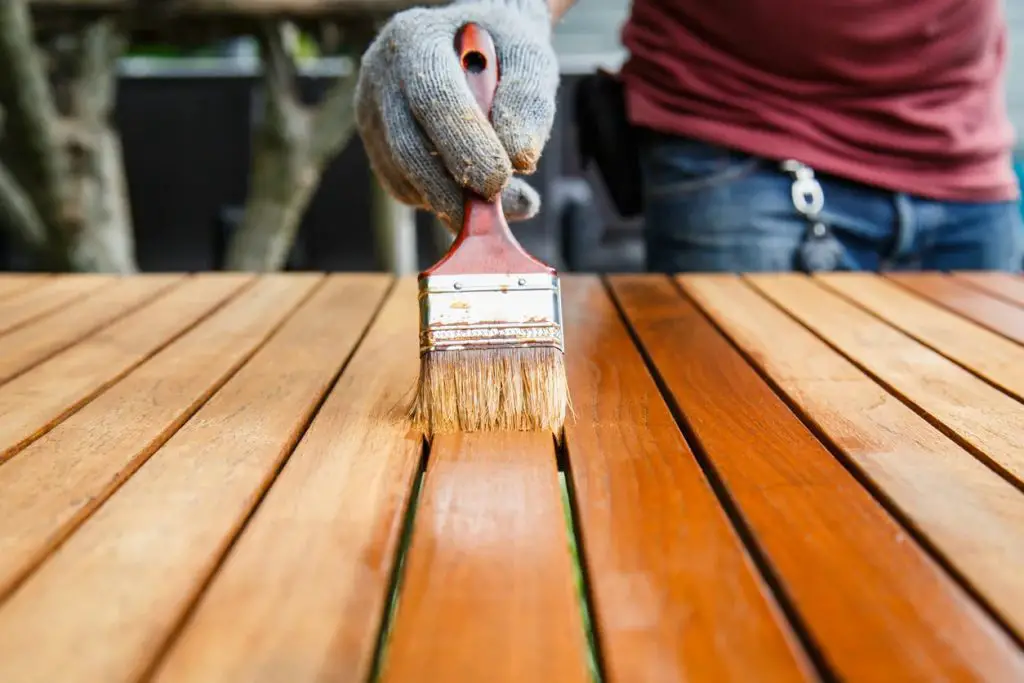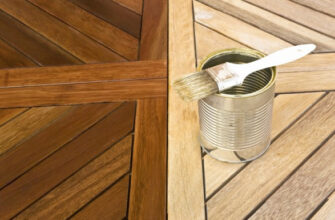Does wood stain go bad? Understanding the shelf life of wood stains used to color wood is crucial for both DIY enthusiasts and professionals in woodworking and carpentry.

Over time, wood stains can degrade, affecting their performance and appearance.
- Why does wood stain go bad?
- Signs that wood stain may have expired
- Different types of stain
- Observable changes in stain’s appearance
- Odor and smell variations
- Mold or mildew growth
- Methods to check the stain’s usability
- Maximizing the shelf life of wood stain
- Restoring or reusing expired wood stain
- Conclusion
- FAQ
- How can you tell if wood stain is still good?
- What can I do with old wood stain?
- Does wood stain get darker as it ages?
- What happens if wood stain freezes?
Why does wood stain go bad?
Wood stains, despite their durability, can degrade over time due to various factors that impact their composition and integrity.
Understanding these factors is essential in comprehending “Why can wood stain go bad and deteriorate?”.
Why does wood stain go bad? Reasons why wood stain expires include:
- Exposure to air and sunlight: when the stain is exposed to air and sunlight for prolonged periods, it undergoes oxidation and photochemical reactions. Oxidation can lead to changes in the chemical structure of the stain, causing it to lose its original color and consistency. Additionally, ultraviolet (UV) rays from sunlight can fade the color pigments present in the stain, altering its appearance.
- Temperature fluctuations: extreme temperature variations affect the shelf life of a wood stain. Fluctuations in temperature can cause the components of the stain to expand and contract, potentially leading to changes in its texture, viscosity, and overall performance. This can result in the separation of components or degradation of the stain’s quality and shelf life.
- Moisture and humidity levels: exposure to high levels of moisture and humidity can negatively impact the shelf life of a wood stain. Moisture can cause the stain to break down or promote mold and mildew growth, leading to discoloration and a compromised finish.
Conversely, low humidity levels might cause the stain to dry out, affecting its application and adherence to the wood surface. - Chemical composition: the chemical composition of wood stains plays a crucial role in their shelf life. Some stains contain volatile compounds that may evaporate over time, altering the stain’s properties. Changes in the formulation or degradation of specific chemicals within the stain can affect its color, viscosity, shelf life, and overall effectiveness.
Signs that wood stain may have expired
Wood stains, when past their prime, exhibit certain noticeable indicators that signify their deterioration. Recognizing these signs is crucial in determining whether the stain is still suitable for use.
Different types of stain
Wood stains come in diverse formulations, each with its unique properties and compositions.
Understanding the differences between these types helps in comprehending how wood stains may degrade over time.
Among the most common stain types are oil-based wood stain, water-based wood stains, and gel stains:
- Oil-based stains: oil-based wood stains stains use natural or synthetic oils as their base. Oil-based stain penetrates deeply into the wood. Oil-based wood stain provides rich color and durability.
- Water-based stains: comprising water as a solvent, water-based stains offer quick drying times and low VOC emissions. Water-based paint is popular for its ease of use and environmentally friendly characteristics.
- Gel stains: gel stains have a thicker consistency, adhering well to vertical surfaces and offering controlled application.
Other types include:
- Alcohol-based stains: alcohol-based wood stains use alcohol as a carrier solvent, providing fast drying times and easy application. These stains are favored for their ability to reveal the natural grain of wood and are often used for projects where quick drying is essential.
- Varnish stains: varnish stains combine the properties of the traditional wood stain with those of varnish, providing both color enhancement and a protective topcoat.
- Lacquer stains: these wood stains are designed to provide both color and a protective finish to wood surfaces.
- Hybrid stains: hybrid stains amalgamate characteristics of different stain types, combining elements of oil-based, water-based, or gel stains. They are engineered to offer specific benefits such as the rich color of oil-based stains, the quick drying of water-based stains, or the controlled application of gel stains.
Observable changes in stain’s appearance
Begin with a simple visual inspection.
Color alteration or separation: expired wood stain often experiences color changes, appearing darker, lighter, or unevenly pigmented.
Separation of components might be visible, with the pigments settling at the bottom of the container, leading to an inconsistent hue when mixed.
Texture and consistency changes: the texture of the expired wood stain may become thicker, lumpy, or gel-like, making it challenging to apply smoothly onto wood surfaces.
Conversely, some stains might thin out excessively, losing their viscosity and becoming runny.
The oil-based stain may show signs of separation, pigment settling, or darkening of color over time. Oil stains might form a film on the surface or become gummy when expired.
Gel stains may harden or become lumpy when expired. Changes in viscosity, color separation, or difficulty in application might indicate spoilage or expiration.
Odor and smell variations
An unusual or pungent odor can be an indication that the wood stain has gone bad.
Foul or significantly different smells compared to when the stain was fresh could suggest chemical breakdown or contamination.
Water-based stains might exhibit mold growth, foul odors, or inconsistency in texture when spoiled. Separation of components or a sour smell can signal degradation.
Mold or mildew growth
The presence of mold or mildew within the stain indicates exposure to moisture.
These growths can alter the stain’s composition and color, rendering it unsuitable for application on wood surfaces.
Methods to check the stain’s usability
Several methods can help assess whether the wood stain is still usable:
- Stirring or shaking the stain: properly mixed stain should have a consistent texture and color. Separation or clumps indicate potential expiration.
- Applying a small amount on a test wood’s surface: testing the stain on a scrap wood can reveal any irregularities in color, consistency, or adhesion.
- Smelling the stain: a strong, off-putting odor might indicate spoilage or chemical changes.
- Checking expiration dates (if provided): some stains come with expiration dates or batch codes indicating manufacturing dates provided by companies’ social media, advertising, and analytics partners. If the stain is past its recommended shelf life, it might have degraded.
By paying attention to these visible and sensory cues, users can determine the usability of the wood stain and avoid applying compromised products to their woodwork projects.
Maximizing the shelf life of wood stain
Properly storing wood stain and using it appropriately can significantly extend its shelf life and maintain its quality.
Implementing suitable opened wood stain storage techniques and usage practices is essential for prolonging the shelf life of the opened wood stain.
Proper storage techniques:
- Suitable wood stain cans: storing wood stain in airtight wood stain cans or original tightly-sealed cans prevents air exposure and air seeping, which can lead to premature oxidation and evaporation of volatile components.
- Proper storage conditions: store unopened cans with wood stain in a cool, dry place away from direct sunlight, fire hazards, and extreme heat. High temperatures and air exposure can degrade the stain and lead to a much shorter shelf life, while excessive moisture or humidity can cause mold growth or thinning of the product.
Usage tips for the longer shelf life of opened stains:
- Avoiding contamination: contaminating the wood stain with foreign substances, such as dirt, dust, or other finishes, can compromise its quality. Use clean tools and tightly sealed wood stain cans when handling or transferring stains. Seal containers tightly, as an airtight seal prevents contamination. After use, wipe off excess stain from its outer rim and replace the lid securely.
- Using suitable application tools: choose appropriate brushes, applicators, or sprayers recommended for the type of wood stain being used. Clean tools thoroughly after each use to prevent residue buildup that could affect future applications.
- Dilution or mixing recommendations: follow manufacturer guidelines regarding dilution or mixing ratios, if applicable. Improper dilution can alter the stain’s composition, affecting its performance and longevity. Mixing thoroughly before use ensures a consistent application and helps maintain the stain’s properties.
By adhering to opened wood stain proper storage practices, such as using appropriate containers, controlling storage conditions, and using correct usage techniques, wood stain users can significantly prolong its shelf life and preserve its quality for future woodworking projects.
Restoring or reusing expired wood stain
Expired or deteriorated wood stain doesn’t necessarily need to be discarded.
There are methods to potentially revitalize its usefulness, along with alternative ways to repurpose it creatively.
Techniques for revitalizing old or thickened stains:
- Thinning with compatible solvents: adding compatible solvents, as recommended by the stain manufacturer, can help thin out thickened or dried-up stains. This process might restore the stain’s original consistency, making it usable again. However, exercise caution not to over-thin the stain, as it might affect its performance.
- Mixing or stirring thoroughly: vigorously stirring or mixing the expired stain can redistribute settled pigments and components, potentially restoring uniformity and consistency. This method might help salvage partially separated stains.
Safety precautions when attempting restoration:
- Ventilation: work in a well-ventilated area to avoid inhaling fumes from solvents or aged stains, as these substances may emit strong odors.
- Protective gear: use appropriate protective gear, such as gloves and a respirator, especially when handling potentially volatile chemicals or concentrated solvents.
- Follow manufacturer recommendations: adhere to any safety guidelines provided by the stain manufacturer when attempting to restore or thin out the product.
If the stain cannot be fully restored or used for its intended purpose, consider alternative ways to repurpose it:
- Creating antique finishes: aged or slightly degraded stains can add character to woodworking projects, creating antique or weathered appearances on certain surfaces.
- Artistic applications: use old stains for artistic endeavors, such as creating wood art pieces, staining small craft projects, or experimenting with unconventional staining techniques.
- DIY wood treatments: use old stains as a wood treatment for non-critical applications, like staining the undersides of furniture or less visible areas in DIY projects.
By using restoration techniques cautiously, prioritizing safety, and exploring creative avenues for repurposing, individuals can potentially salvage or find alternative uses for expired wood stains, minimizing waste and maximizing its usefulness.
Conclusion
By adopting appropriate storage practices, recognizing signs of spoilage, and exploring restoration or creative repurposing options, individuals can make informed decisions about the usability and potential revitalization of their wood stains.
Ultimately, proactive management and understanding of wood stain expiration contribute to efficient and successful woodworking projects while minimizing waste and maximizing the usefulness of these valuable finishing products.
FAQ
How can you tell if wood stain is still good?
Signs of good wood stain include a consistent color and texture.
If the stain has not separated, exhibits a uniform hue, and smells normal without any signs of mold or foul odor, it’s likely still in good condition.
What can I do with old wood stain?
Old wood stains can often be revitalized by stirring thoroughly or adding compatible solvents to restore their consistency.
Alternatively, if the stain cannot be restored, consider repurposing it for smaller projects, creating antique finishes, or using it for artistic endeavors.
Does wood stain get darker as it ages?
Yes, some wood stains can darken over time due to factors like oxidation or exposure to sunlight.
Oil-based stains, in particular, may darken or change in hue as they age.
What happens if wood stain freezes?
Freezing temperatures can potentially alter the texture and consistency of a wood stain. When thawed, the components might separate or the stain’s properties could change.
It’s advisable to avoid subjecting the wood stain to freezing temperatures to maintain its quality.
If exposed to freezing conditions, thoroughly inspect the stain for any signs of damage or separation before use.







![What is a Wood Planer? [4 Types of Wood Planers] What Is A Wood Planer: Best Helpful Guide & Top Review](https://bestwoodforcarving.com/wp-content/uploads/2023/12/What-is-a-Wood-Planer-335x220.jpg)



